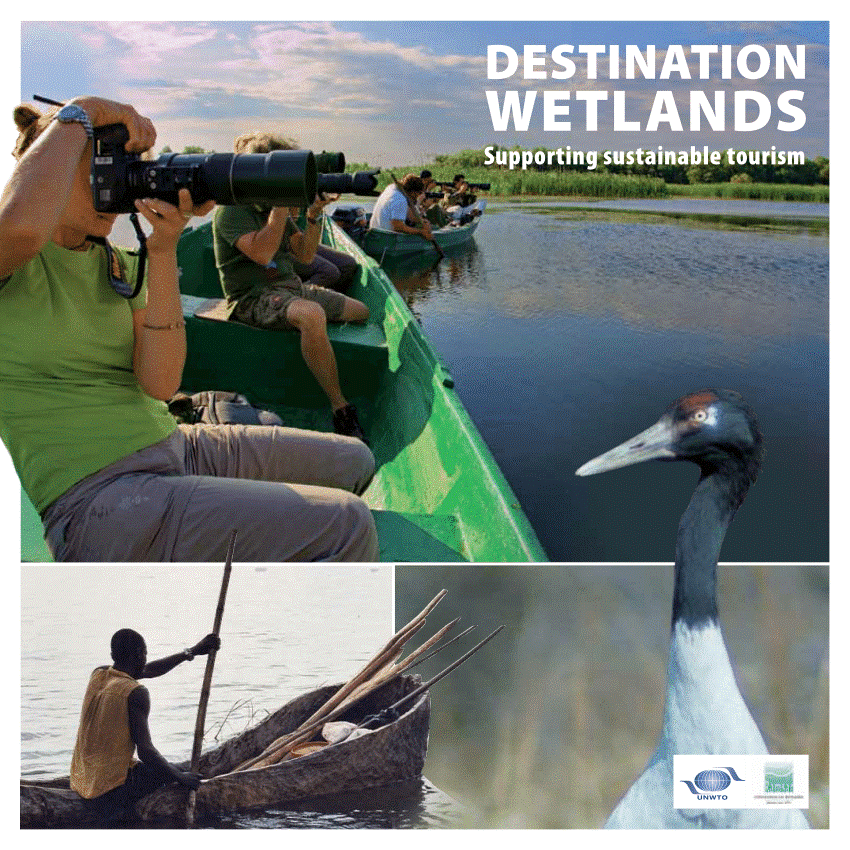
Disclaimer: Copyright infringement not intended.
Context
- The Central government has embarked on a mission to promote tourism at ecologically-sensitive wetlands better known as Ramsar sites.
Central Government's Ramsar Sites Tourism Promotion Initiative:
Objective:
- Promoting tourism at ecologically sensitive wetlands designated as Ramsar sites in India.
- Shifting focus from high-value tourism to nature tourism.
- Supporting conservation actions while empowering local communities and economies.
Ramsar Sites in India:
- India has 75 Ramsar sites, including Chilika Lake in Odisha, Sultanpur Bird Sanctuary in Haryana, Sundarbans in West Bengal, and Chitrangudi Bird Sanctuary in Tamil Nadu.
- Ramsar sites are wetlands of international importance, identified under a UNESCO environmental treaty.
Amrit Dharohar Capacity Building Scheme 2023:
- Joint initiative by the Union Tourism Ministry and the Ministry of Environment, Forest and Climate Change.
- Launched under the 2023-24 budget announcement.
- Aims to promote the conservation values of Ramsar Sites, generate employment, and support local livelihoods.
Implementation:
- Implemented in convergence with various Central Government ministries, state wetland authorities, and a network of institutions and individuals.
- In association with the State Tourism Department.
Nature Tourism vs High-Volume Tourism:
- Focus on shifting from high-volume tourism to high-value nature tourism.
- Targeting high-value travelers interested in diverse natural and cultural resources.
- Nature tourism activities include birdwatching, photography, stargazing, camping, hiking, hunting, fishing, and visiting parks.
Training Programs:
- Training facilitators, tourism service providers, and stakeholders for strengthening nature tourism.
- 16 Ramsar sites identified, with 5 selected as pilot projects for skill development.
- Training programs include Alternative Livelihood Programme (ALP) and Paryatan Navik Certificate for boatmen certification.
Pilot Projects:
- Pilot projects conducted at Sultanpur National Park (Haryana), Bhitarkanika Mangroves (Odisha), Chilika Lake (Odisha), Sirpur (Madhya Pradesh), and Yashwant Sagar (Madhya Pradesh).
- Participants undergo 15-day training under ALP, focusing on alternative livelihoods.
Significance:
- Wetlands are essential for global biodiversity conservation and sustaining human life.
- Nature tourism at Ramsar sites enhances livelihood opportunities for local communities.
Future Steps:
- Ongoing efforts to complete training programs at Bhitarkanika and Chilika in Odisha.
- Expanding the initiative to cover more Ramsar sites in the future.
- This initiative underscores the commitment to sustainable tourism, conservation, and community development at ecologically significant Ramsar sites in India.
Wetland Tourism
- Wetland tourism, a facet of ecotourism, involves the exploration and enjoyment of wetland ecosystems, which include areas like marshes, swamps, lakes, rivers, and coastal zones.
Ecological Significance:
Biodiversity Hotspots:
- Wetlands host a myriad of species, including amphibians, reptiles, and a variety of aquatic plants, contributing to high biodiversity.
- Migratory birds often find refuge in wetlands, making them critical stopover points during their journeys.
Water Purification:
- The intricate vegetation and microbial communities in wetlands act as natural filters, enhancing water quality.
- Wetlands mitigate the impact of pollutants, ensuring the health of downstream ecosystems.
Ecosystem Services:
- Flood regulation provided by wetlands prevents disasters by acting as natural sponges that absorb excess water during heavy rainfall.
- Groundwater recharge occurs as wetlands store water, maintaining aquifer levels.
Ramsar Sites and International Importance:
Ramsar Convention:
- The Ramsar Convention, signed in 1971, underscores the global commitment to the conservation and sustainable use of wetlands.
- Ramsar sites are chosen based on their ecological significance, especially for waterfowl habitats.
Global Cooperation:
- International collaboration at Ramsar sites involves sharing knowledge, resources, and best practices in wetland conservation.
- Member countries cooperate to address transboundary wetland issues and promote biodiversity.
Cultural and Recreational Value:
Cultural Heritage:
- Wetlands often hold cultural and historical significance, with indigenous communities relying on them for traditional practices and rituals.
- Cultural events and festivals centered around wetlands showcase the deep connection between communities and their natural surroundings.
Recreational Opportunities:
- Birdwatching enthusiasts flock to wetlands to observe diverse avian species, creating opportunities for eco-friendly tourism.
- Activities like kayaking, nature walks, and photography provide visitors with memorable and educational experiences.
Conservation through Tourism:
Alternative Livelihoods:
- Tourism revenue can replace unsustainable practices like overfishing or habitat destruction, offering alternative livelihoods for local communities.
- Employment in eco-tourism empowers residents, fostering a sense of responsibility towards wetland conservation.
Community Involvement:
- Engaging local communities in tourism planning and decision-making ensures that their traditional knowledge contributes to sustainable practices.
- Conservation awareness programs for communities create a shared responsibility for protecting wetlands.

Challenges associated with Wetland Tourism
Ecological Impact:
- Overcrowding: High tourist footfall may disturb the natural habitat and breeding grounds of flora and fauna.
- Pollution: Increased human activity can lead to pollution of water bodies and surrounding areas.
Socio-economic Concerns:
- Displacement: Development of tourism infrastructure might displace local communities or alter their traditional ways of life.
- Inequality: Unequal distribution of economic benefits, with some locals benefitting more than others.
Cultural Disturbance:
- Cultural Erosion: The influx of tourists may impact local cultures and traditional practices.
- Loss of Identity: Commercialization can lead to the loss of cultural authenticity
Lack of Awareness:
- Environmental Education: Insufficient awareness among tourists about the ecological importance of wetlands.
- Irresponsible Behavior: Tourists may engage in activities that harm the environment due to a lack of awareness.
Regulatory Challenges:
- Inadequate Enforcement: Weak enforcement of regulations related to waste disposal, wildlife protection, and sustainable tourism practices.
- Policy Gaps: Lack of comprehensive policies addressing the specific needs and challenges of wetland tourism.
Climate Change Vulnerability:
- Climate-Related Risks: Wetlands are vulnerable to climate change, affecting tourism activities and infrastructure.
- Extreme Events: Increased frequency of extreme weather events can disrupt tourism operations.
Infrastructure Development:
- Unplanned Growth: Rapid tourism development may lead to poorly planned infrastructure, causing long-term environmental degradation.
- Ecological Carrying Capacity: Failure to assess and respect the ecological carrying capacity of wetland areas.
Conservation Balancing Act:
- Tourism vs. Conservation: Striking a balance between promoting tourism for economic growth and conserving the delicate wetland ecosystems.
- Biodiversity Conservation: Ensuring tourism practices do not compromise the conservation of diverse flora and fauna.
Addressing these challenges requires a comprehensive approach involving community participation, sustainable tourism practices, effective regulations, and continuous monitoring of environmental impacts.
Policy measures for responsible development of wetland tourism:
Ecotourism Regulations:
- Enforce and strengthen regulations that promote ecotourism practices, ensuring minimal ecological impact.
- Implement visitor capacity limits in sensitive areas to prevent overcrowding.
Community Involvement:
- Develop policies to actively involve local communities in decision-making processes related to tourism development.
- Promote community-based tourism initiatives to ensure equitable economic benefits.
Environmental Education:
- Integrate environmental education into tourism programs, enlightening visitors about the ecological importance of wetlands.
- Collaborate with educational institutions to conduct awareness campaigns.
Zoning and Planning:
- Establish clearly defined zones for different activities, such as boating, bird watching, and hiking, to minimize disturbance.
- Implement comprehensive master plans for wetland tourism development with a focus on sustainability.
Waste Management:
- Enforce stringent waste management policies, including waste reduction strategies and proper disposal mechanisms.
- Introduce incentives for businesses adopting eco-friendly practices.
Cultural Preservation:
- Develop policies to safeguard and promote local cultures, traditions, and indigenous knowledge.
- Encourage responsible tourism practices that respect the cultural integrity of host communities.
Tourism Impact Assessments:
- Mandate thorough environmental and socio-economic impact assessments before initiating any tourism projects.
- Ensure periodic evaluations to adapt policies based on changing conditions.
Climate Resilience:
- Integrate climate-resilient measures into tourism infrastructure to withstand climate change impacts.
- Develop contingency plans for extreme weather events affecting wetland areas.
Biodiversity Conservation:
- Implement measures to protect and enhance biodiversity, such as creating buffer zones and wildlife corridors.
- Support research initiatives to monitor and mitigate any adverse effects on local flora and fauna.
Public-Private Partnerships:
- Foster collaboration between the government, private sector, and local communities for sustainable tourism development.
- Encourage private enterprises to adhere to responsible tourism practices through incentives and certifications.
Monitoring and Enforcement:
- Establish a robust monitoring system to track tourism activities and their impacts.
- Strengthen enforcement mechanisms, including penalties for violations of responsible tourism guidelines.
Tourism Certification Programs:
- Introduce certification programs recognizing businesses adhering to sustainable and responsible tourism practices.
- Encourage tourists to choose certified providers through awareness campaigns.
Sustainable Practices:
Educational and Research Opportunities:
Learning Centers:
- Establishing educational centers at wetland tourist destinations enhances visitor understanding of the ecological importance of wetlands.
- Interpretative programs led by trained guides provide insights into the unique flora and fauna of wetland ecosystems.
Scientific Research:
- Tourism activities can fund scientific research initiatives, leading to discoveries about previously unknown species and ecosystem dynamics.
- Citizen science programs engage tourists in data collection, contributing to ongoing research efforts.
Stakeholder Collaboration:
Government Initiatives:
- Governments play a crucial role in developing and implementing policies that balance tourism development with wetland conservation.
- Collaboration between government bodies, NGOs, and local authorities ensures a holistic approach to wetland management.
Public-Private Partnerships:
- Involving the private sector in wetland tourism development requires partnerships that prioritize sustainable infrastructure and responsible tourism practices.
- Joint initiatives between government agencies, NGOs, and private entities can enhance the overall impact of wetland conservation efforts.
Role of Tour Operators and Guides:
Environmental Education:
- Tour operators and guides act as ambassadors for wetland conservation, providing visitors with accurate information about the fragility and importance of these ecosystems.
- Training programs for guides should focus on effective communication and interpretation skills to convey conservation messages.
Responsible Practices:
- Implementing guidelines for responsible tourism practices, such as no littering, maintaining a safe distance from wildlife, and respecting natural habitats, ensures minimal impact.
- Tour operators can contribute to conservation by actively participating in wetland restoration projects and biodiversity monitoring.
Future Trends and Opportunities:
Nature Tourism:
- Nature tourism trends indicate a growing interest in experiential travel, emphasizing meaningful interactions with natural environments.
- Utilizing digital platforms for virtual experiences and educational outreach enhances the accessibility of wetland tourism.
Technology Integration:
- Technological advancements, including mobile apps for self-guided tours and augmented reality experiences, enhance the educational value of wetland tourism.
- Real-time monitoring through technology helps manage visitor impact and ensure adherence to conservation guidelines.
Global Examples:
Everglades National Park, USA:
- A UNESCO World Heritage Site and Ramsar Wetland, the Everglades offers diverse ecosystems, including mangrove swamps, providing opportunities for wildlife enthusiasts.
- Sustainable tourism practices, including ranger-led eco-tours, showcase the importance of balancing conservation and recreation.
Okavango Delta, Botswana:
- Recognized as a Ramsar site, the Okavango Delta's pristine wetlands attract travelers seeking unique safari experiences.
- Community-based tourism initiatives empower local residents and demonstrate the compatibility of conservation with economic opportunities.

Conclusion
- In conclusion, wetland tourism, when approached responsibly and sustainably, holds immense potential for fostering environmental stewardship, supporting local economies, and providing unforgettable experiences for visitors.
- Balancing the enjoyment of nature with conservation efforts ensures the longevity of these precious ecosystems for generations to come.
List of Ramsar sites in India [Updated – December 2023]
|
Ramsar Sites in India
|
State – Location
|
|
Karikili Bird Sanctuary
|
Tamil Nadu
|
|
Pallikaranai Marsh Reserve Forest
|
Tamil Nadu
|
|
Pichavaram Mangrove
|
Tamil Nadu
|
|
Sakhya Sagar
|
Madhya Pradesh
|
|
Pala Wetlands
|
Mizoram
|
|
Khijadia Wildlife Sanctuary
|
Gujarat
|
|
Bakhira Wildlife Sanctuary
|
Uttar Pradesh
|
|
Haiderpur Wetland
|
Uttar Pradesh
|
|
Sultanpur National Park
|
Haryana
|
|
Bhindawas Wildlife Sanctuary
|
Haryana
|
|
Thol Lake Wildlife Sanctuary
|
Gujarat
|
|
Wadhvana Wetland
|
Gujarat
|
|
Ashtamudi Wetland
|
Kerala
|
|
Beas Conservation Reserve
|
Punjab
|
|
Bhitarkanika Mangroves
|
Odisha
|
|
Bhoj Wetlands
|
Madhya Pradesh
|
|
Chandra Taal
|
Himachal Pradesh
|
|
Chilika Lake
|
Odisha
|
|
Deepor Beel
|
Assam
|
|
East Kolkata Wetlands
|
West Bengal
|
|
Harike Wetlands
|
Punjab
|
|
Hokera Wetland
|
Jammu & Kashmir
|
|
Kanjli Wetland
|
Punjab
|
|
Keoladeo National Park
|
Rajasthan
|
|
Keshopur-Miani Community Reserve
|
Punjab
|
|
Kolleru lake
|
Andhra Pradesh
|
|
Loktak lake
|
Manipur
|
|
Nalsarovar Bird sanctuary
|
Gujarat
|
|
Nandur Madhameshwar
|
Maharashtra
|
|
Nangal Wildlife Sanctuary
|
Punjab
|
|
Nawabganj Bird Sanctuary
|
Uttar Pradesh
|
|
Parvati Agra Bird Sanctuary
|
Uttar Pradesh
|
|
Point Calimere Wildlife and Bird Sanctuary
|
Tamil Nadu
|
|
Pong Dam lake
|
Himachal Pradesh
|
|
Renuka lake
|
Himachal Pradesh
|
|
Ropar Wetland
|
Punjab
|
|
Rudrasagar Lake
|
Tripura
|
|
Saman Bird Sanctuary
|
Uttar Pradesh
|
|
Samaspur Bird Sanctuary
|
Uttar Pradesh
|
|
Sambhar lake
|
Rajasthan
|
|
Sandi Bird Sanctuary
|
Uttar Pradesh
|
|
Sarsai Nawar Jheel
|
Uttar Pradesh
|
|
Sasthamkotta lake
|
Kerala
|
|
Surinsar- Mansar lakes
|
Jammu & Kashmir
|
|
Tsomoriri Lake
|
Ladakh
|
|
Upper Ganga river
|
Uttar Pradesh
|
|
Vembanad Kol Wetland
|
Kerala
|
|
Wular lake
|
Jammu & Kashmir
|
|
Sunderban Wetland
|
West Bengal
|
|
Asan Barrage
|
Uttarakhand
|
|
Kanwar Lake or Kabal Taal
|
Bihar
|
|
Lonar Lake
|
Maharashtra
|
|
Sur Sarovar
|
Uttar Pradesh
|
|
Tso Kar Wetland Complex
|
Ladakh
|
|
Nanda Lake
|
Goa
|
|
Khijadiya Bird Sanctuary
|
Gujarat
|
|
Hokersar Wetland
|
Jammu & Kashmir
|
|
Hygam Wetland Conservation Reserve
|
Jammu & Kashmir
|
|
Shallbugh Wetland Conservation Reserve
|
Jammu & Kashmir
|
|
Surinsar-Mansar Lakes
|
Jammu & Kashmir
|
|
Ranganathittu Bird Sanctuary
|
Karnataka
|
|
Sirpur Lake
|
Madhya Pradesh
|
|
Yashwant Sagar
|
Madhya Pradesh
|
|
Thane Creek
|
Maharashtra
|
|
Ansupa Lake
|
Odisha
|
|
Hirakud Reservoir
|
Odisha
|
|
Satkosia Gorge
|
Odisha
|
|
Chitrangudi Bird Sanctuary
|
Tamil Nadu
|
|
Gulf of Mannar Marine Biosphere Reserve
|
Tamil Nadu
|
|
Kanjirankulam Bird Sanctuary
|
Tamil Nadu
|
|
Koonthankulam Bird Sanctuary
|
Tamil Nadu
|
|
Pallikarnai Marsh Reserve Forest
|
Tamil Nadu
|
|
Suchindram Theroor Wetland Complex
|
Tamil Nadu
|
|
Udhayamarthandapuram Bird Sanctuary
|
Tamil Nadu
|
|
Vadavur Bird Sanctuary
|
Tamil Nadu
|
|
Vedanthangal Bird Sanctuary
|
Tamil Nadu
|
|
Vellode Bird Sanctuary
|
Tamil Nadu
|
|
Vembannur Wetland Complex
|
Tamil Nadu
|
|
Vellode Bird Sanctuary
|
Tamil Nadu
|
|
Parvati Arga Bird Sanctuary
|
Uttar Pradesh
|
|
Sundarban Wetland
|
West Bengal
|
|
PRACTICE QUESTION
Q. Examine the role of wetland tourism in promoting sustainable conservation, addressing ecological, economic, and cultural aspects. Discuss challenges associated with wetland tourism, propose policy measures for responsible development, and highlight successful initiatives with their impact on local communities and biodiversity.
|




